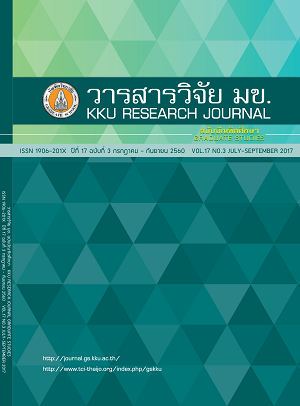The Effect of Applied Plyometric Training Program on Anthropometry, Muscle Strength Test and Flexibility Test in Male Thai Boxing Athletes (ผลของการฝึกพลัยโอเมตริกแบบประยุกต์ต่อการวัดขนาดของร่างกาย การทดสอบความแข็งแรงของกล้ามเนื้อ และการทดสอบความอ่อนตัว ใ
Keywords:
Applied plyometric training program (การฝึกพลัยโอเมตริกแบบประยุกต์), Anthropometry (การวัดขนาดของร่างกาย), Muscle strength (ความแข็งแรงของกล้ามเนื้อ), Flexibility (ความอ่อนตัว), Thai boxing athletes (นักกีฬามวยไทย)Abstract
Thai boxing is one of the oldest cultural martial art of Thailand. Nowadays, Thai boxing can be applied as an exercise model for health promotion. The aim of this study is to investigate the effect of applied plyometric training (PTP) on anthropometry, muscle strength and flexibility test in male Thai boxing athletes. In applied plyometric training group (PTG; n = 17), subjects are trained by using normal Thai boxing training program (NTP) 5 days / week add with the PTP 50 minutes / session (10 minutes warm up, 30 minutes plyometric exercise of 85-100% HRmax, 10 minutes cool down) for 2 days / week in consecutive 12 weeks. While, subjects in control group (CG; n = 16) are practiced only NTP. Results of baseline characteristics showed no significantly difference both in CG and PTG. Muscle strength test such as hand grips, leg strength and flexibility test were shown increase highly significant difference (p<0.001) within PTG, but not within CG when they were compared at pre - test period (week 1), mid - test period (week 7) and post - test period (week 14). However, only result of leg strength test was shown different increase 12.25% from 154.06 ± 16.93 kg to 172.94 ± 21.59 kg (p<0.001) at post test (week 14) when it is compared between CG and PTG. It is concluded that PTP has effectiveness muscle strength especially in leg strength in male Thai boxing athletes.
มวยไทยเป็นศิลปวัฒธรรมที่เก่าแก่ที่สุดอย่างหนึ่งของประเทศไทย ปัจจุบันมวยไทยได้ถูกประยุกต์มาเป็นรูปแบบของการออกกำลังกาย เพื่อการสร้างเสริมสุขภาพ วัตถุประสงค์ของการวิจัยเพื่อศึกษาผลของรูปแบบการฝึกพลัยโอเมตริกแบบประยุกต์ต่อการวัดขนาดของร่างกาย ความแข็งแรงของกล้ามเนื้อ และความอ่อนตัวในนักกีฬามวยไทยชาย ในอาสาสมัครกลุ่มฝึกพลัยโอเมตริกแบบประยุกต์ (17 ราย) จะถูกฝึกโดยใช้รูปแบบการฝึกมวยไทยปกติ (NTP) 5 วันต่อ สัปดาห์ และเพิ่มฝึกพลัยโอเมตริกแบบประยุกต์ 50 นาทีต่อครั้ง (อบอุ่นกาย10 นาที ฝึกพลัยโอเมตริกแบบประยุกต์ 30 นาที ที่ระดับความหนัก 85 - 100 % ของอัตราการเต้นหัวใจสูงสุด (HRmax) คลายอุ่น10 นาที) เป็นเวลา 2 วัน ต่อเนื่องกัน 12 สัปดาห์ ขณะที่อาสาสมัครกลุ่มควบคุม (16 ราย) จะถูกฝึกเฉพาะรูปแบบการฝึกมวยไทยปกติ ผลการประเมินลักษณะพื้นฐาน พบว่าไม่มีความแตกต่างทางสถิติในกลุ่มควบคุมและกลุ่มฝึกพลัยโอเมตริกแบบประยุกต์ ความแข็งแรงชองกล้ามเนื้อได้แก่การวัดแรงบีบมือ แรงเหยียดขา และความอ่อนตัว พบว่ามีความแตกต่างอย่างมีนัยสำคัญทางสถิติ (p<0.001) ภายในกลุ่มฝึกพลัยโอเมตริกแบบประยุกต์ แต่ไม่แตกต่างภายในกลุ่มควบคุม อย่างไรก็ตามมีเพียงความแตกต่างอย่างมีนัยสำคัญทางสถิติ (p<0.001) ของความแข็งแรงของขาเพิ่มขึ้น 12.25 % จาก 154.06 ± 16.93 กิโลกรัม เป็น 172.94 ± 21.59 กิโลกรัม หลังการทดสอบ (สัปดาห์ที่ 14) เมื่อเปรียบเทียบกลุ่มควบคุมและกลุ่มฝึกพลัยโอเมตริก แบบประยุกต์ ผลการศึกษาสรุปว่ารูปแบบการฝึกพลัยโอเมตริกแบบประยุกต์ที่สร้างขึ้น มีผลต่อแข็งแรงของกล้ามเนื้อโดยเฉพาะกล้ามเนื้อขาในนักกีฬามวยไทยชายได้



